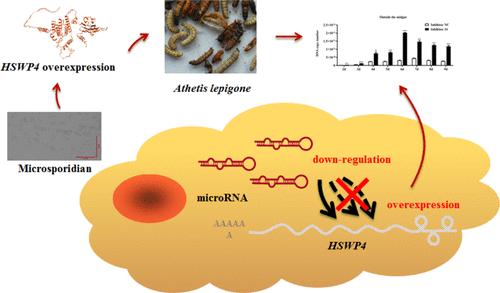miR-PC-3p-241582_34 Contributes to the Infection of Athetis lepigone by Regulating the Expression of HSWP4 in Nosema bombycis
IF 5.7
1区 农林科学
Q1 AGRICULTURE, MULTIDISCIPLINARY
引用次数: 0
Abstract
Athetis lepigone is a recurring pest in the maize seedling stage under the wheat-maize no-tillage direct seeding system in China’s summer maize region. Our previous research identified a highly pathogenic Nosema bombycis to A. lepigone, which spore wall protein plays an important role in the infection process. However, the regulatory mechanism of this spore wall protein is still unclear. In this study, we explored the regulatory mechanism of miRNAs on spore wall proteins. Transcriptome sequencing results showed that expression of the spore wall protein, HSWP4, significantly increased in the germination group compared to dormancy group. Silencing of HSWP4 reduced the number of microsporidian spores breaking through the midgut wall cells of A. lepigone. Association analysis of small RNA and mRNA revealed that the targeting site of miR-PC-3p-241582_34 on HSWP4 was located in the CDS region, and miR-PC-3p-241582_34 had a significant negative regulatory relationship with HSWP4. The dual luciferase reporter assay demonstrated that miR-PC-3p-241582_34 significantly affected the luciferase activity of the HSWP4-3′UTR expression vector (P < 0.05). Delivery of miRNA mimics decreased the expression of HSWP4 and inhibited the behavior of microsporidian spores breaking through the midgut wall of A. lepigone. On the other hand, delivery of inhibitors produced opposite results, indicating that the miR-HSWP4 pathway plays an important role in microsporidian infection of A. lepigone. This study provides a new theoretical basis for understanding the pathogenic mechanism and gene regulation of microsporidia, as well as for the green control of A. lepigone.

miR-PC-3p-241582_34 通过调控 Nosema bombycis 中 HSWP4 的表达对 Athetis lepigone 的感染做出贡献
玉米螟是我国夏玉米地区小麦玉米免耕直播制玉米苗期的一种常发害虫。我们之前的研究发现了一种对玉米螟具有高致病性的 Nosema bombycis,其孢子壁蛋白在感染过程中起着重要作用。然而,这种孢子壁蛋白的调控机制仍不清楚。本研究探讨了 miRNA 对孢子壁蛋白的调控机制。转录组测序结果显示,与休眠组相比,孢子发芽组孢子壁蛋白HSWP4的表达量显著增加。沉默HSWP4可减少小孢子虫孢子突破A. lepigone中肠壁细胞的数量。小 RNA 和 mRNA 的关联分析表明,miR-PC-3p-241582_34 对 HSWP4 的靶向位点位于 CDS 区域,miR-PC-3p-241582_34 与 HSWP4 存在显著的负调控关系。双荧光素酶报告实验表明,miR-PC-3p-241582_34 明显影响 HSWP4-3′UTR 表达载体的荧光素酶活性(P < 0.05)。miRNA模拟物的递送降低了HSWP4的表达,并抑制了小孢子虫孢子突破A. lepigone中肠壁的行为。另一方面,递送抑制剂产生了相反的结果,表明 miR-HSWP4 通路在小孢子虫感染 A. lepigone 的过程中发挥了重要作用。该研究为了解微孢子虫的致病机制和基因调控,以及A. lepigone的绿色防控提供了新的理论依据。
本文章由计算机程序翻译,如有差异,请以英文原文为准。
求助全文
约1分钟内获得全文
求助全文
来源期刊
CiteScore
9.90
自引率
8.20%
发文量
1375
审稿时长
2.3 months
期刊介绍:
The Journal of Agricultural and Food Chemistry publishes high-quality, cutting edge original research representing complete studies and research advances dealing with the chemistry and biochemistry of agriculture and food. The Journal also encourages papers with chemistry and/or biochemistry as a major component combined with biological/sensory/nutritional/toxicological evaluation related to agriculture and/or food.

 求助内容:
求助内容: 应助结果提醒方式:
应助结果提醒方式:


